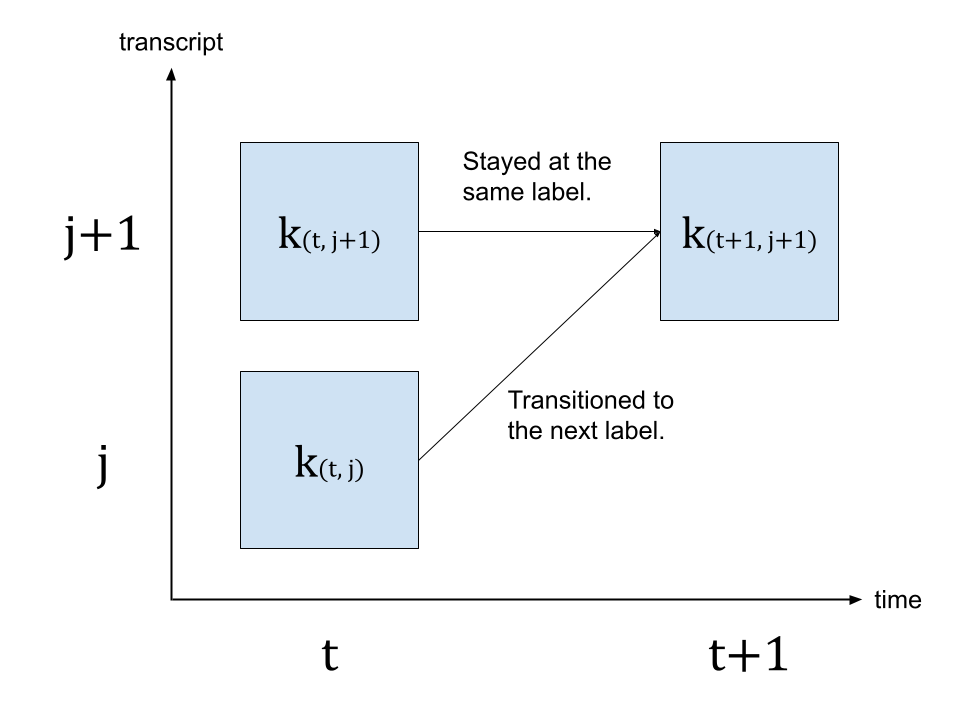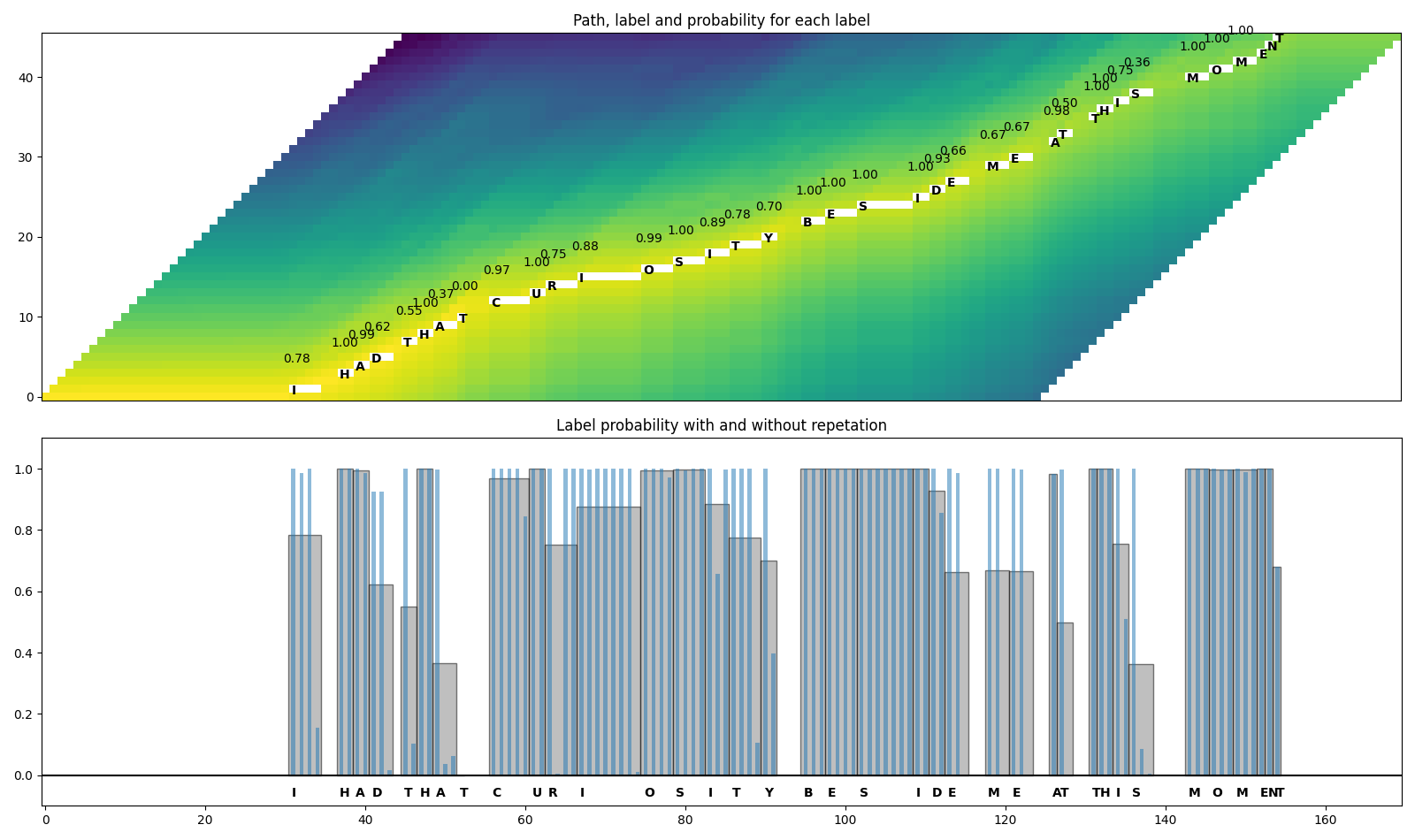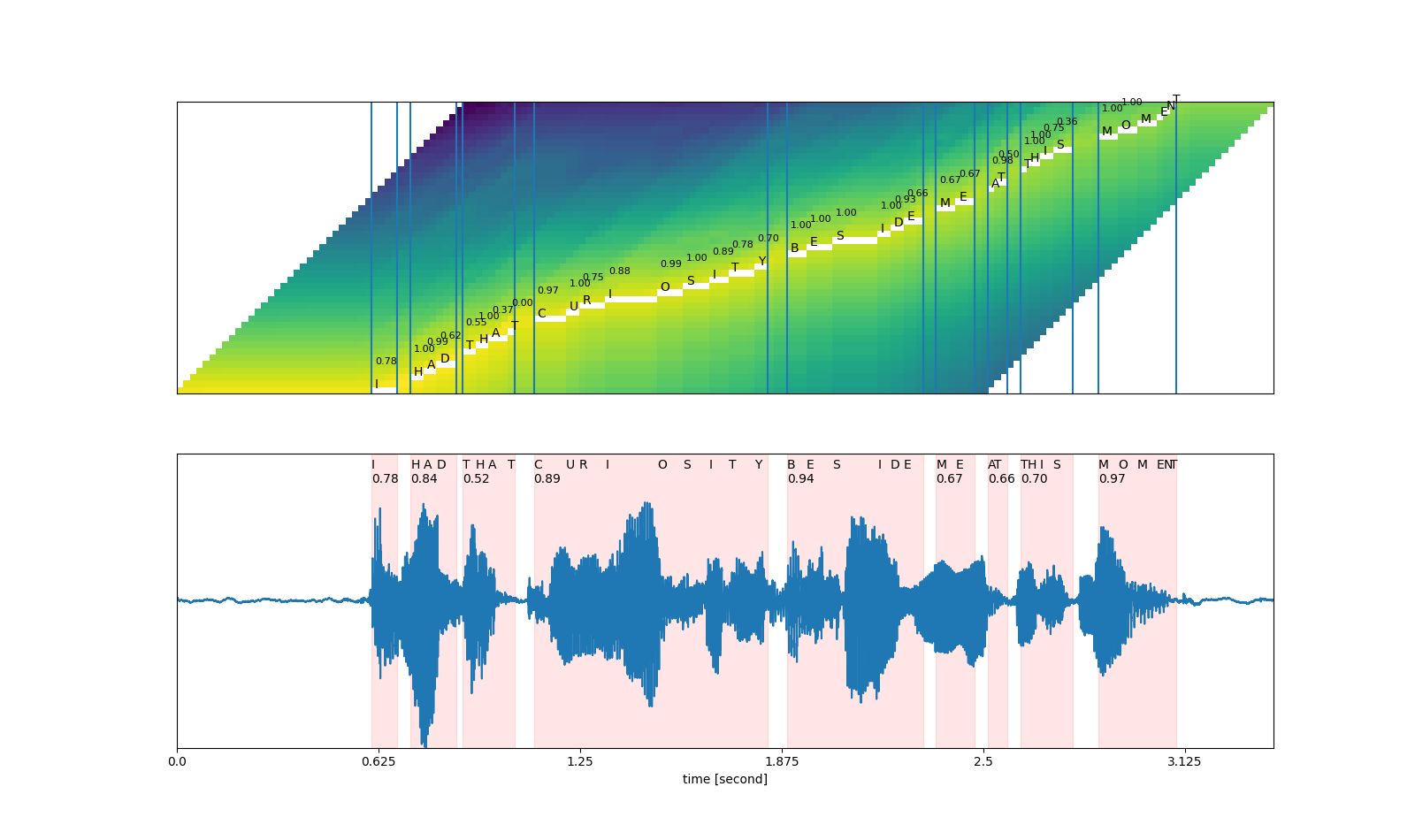注意
单击此处下载完整的示例代码
使用 Wav2Vec2 强制对齐¶
作者: Moto Hira
本教程介绍如何使用 CTC - Segmentation of Large Corpora for German End-to-end speech 中描述的 CTC 分割算法将转录与语音对齐
认可。torchaudio
import torch
import torchaudio
print(torch.__version__)
print(torchaudio.__version__)
device = torch.device("cuda" if torch.cuda.is_available() else "cpu")
print(device)
2.0.0
2.0.1
cpu
概述¶
对齐过程如下所示。
从音频波形估计逐帧标签概率
生成网格矩阵,该矩阵表示 标签在时间步长对齐。
从格状图矩阵中查找最可能的路径。
在此示例中,我们使用 的模型
声学特征提取。torchaudioWav2Vec2
制备¶
首先,我们导入必要的包,并获取我们处理的数据。
# %matplotlib inline
from dataclasses import dataclass
import IPython
import matplotlib
import matplotlib.pyplot as plt
matplotlib.rcParams["figure.figsize"] = [16.0, 4.8]
torch.random.manual_seed(0)
SPEECH_FILE = torchaudio.utils.download_asset("tutorial-assets/Lab41-SRI-VOiCES-src-sp0307-ch127535-sg0042.wav")
生成逐帧标签概率¶
第一步是生成每个 aduio 的标签类 porbability
框架。我们可以使用针对 ASR 训练的 Wav2Vec2 模型。这里我们使用torchaudio.pipelines.WAV2VEC2_ASR_BASE_960H().
torchaudio轻松访问带有关联
标签。
注意
在后续部分中,我们将计算
log-domain 以避免数值不稳定。为此,我们
用 规范化 。emissiontorch.log_softmax()
bundle = torchaudio.pipelines.WAV2VEC2_ASR_BASE_960H
model = bundle.get_model().to(device)
labels = bundle.get_labels()
with torch.inference_mode():
waveform, _ = torchaudio.load(SPEECH_FILE)
emissions, _ = model(waveform.to(device))
emissions = torch.log_softmax(emissions, dim=-1)
emission = emissions[0].cpu().detach()
可视化¶
print(labels)
plt.imshow(emission.T)
plt.colorbar()
plt.title("Frame-wise class probability")
plt.xlabel("Time")
plt.ylabel("Labels")
plt.show()

('-', '|', 'E', 'T', 'A', 'O', 'N', 'I', 'H', 'S', 'R', 'D', 'L', 'U', 'M', 'W', 'C', 'F', 'G', 'Y', 'P', 'B', 'V', 'K', "'", 'X', 'J', 'Q', 'Z')
生成对齐概率(格状图)¶
从发射矩阵中,接下来我们生成网格,它表示 转录标签在每个时间范围内出现的概率。
Trellis 是具有时间轴和标签轴的 2D 矩阵。标签轴 表示我们正在对齐的转录本。在下文中,我们使用 \(t\) 表示时间轴上的索引,使用 \(j\) 表示 label axis 中的 index。\(c_j\) 表示标签索引为 \(j\) 的标签。
为了生成时间步长 \(t+1\) 的概率,我们查看 来自时间步 \(t\) 的网格和时间步 \(t+1\) 的发射。 有两条路径可以到达标签为 \(c_{j+1}\) 的时间步 \(t+1\)。第一种情况是标签在 \(t\) 处为 \(c_{j+1}\),并且标签从 \(t\) 到 \(t+1\) 没有变化。另一种情况是,标签在 \(t\) 处为 \(c_j\),然后在 \(t+1\) 处过渡到下一个标签 \(c_{j+1}\)。
下图说明了此转换。

由于我们正在寻找最可能的过渡,因此我们采取的 \(k_{(t+1, j+1)}\) 的值的可能路径,即
\(k_{(t+1, j+1)} = max( k_{(t, j)} p(t+1, c_{j+1}), k_{(t, j+1)} p(t+1, repeat) )\)
其中 \(k\) 表示是网格矩阵,\(p(t, c_j)\) 表示标签 \(c_j\) 在时间步 \(t\) 出现的概率。\(repeat\) 表示 CTC 公式中的空白词元。(对于 详细介绍 CTC 算法,请参考 使用 CTC 进行序列建模 [distill.pub])
transcript = "I|HAD|THAT|CURIOSITY|BESIDE|ME|AT|THIS|MOMENT"
dictionary = {c: i for i, c in enumerate(labels)}
tokens = [dictionary[c] for c in transcript]
print(list(zip(transcript, tokens)))
def get_trellis(emission, tokens, blank_id=0):
num_frame = emission.size(0)
num_tokens = len(tokens)
# Trellis has extra diemsions for both time axis and tokens.
# The extra dim for tokens represents <SoS> (start-of-sentence)
# The extra dim for time axis is for simplification of the code.
trellis = torch.empty((num_frame + 1, num_tokens + 1))
trellis[0, 0] = 0
trellis[1:, 0] = torch.cumsum(emission[:, 0], 0)
trellis[0, -num_tokens:] = -float("inf")
trellis[-num_tokens:, 0] = float("inf")
for t in range(num_frame):
trellis[t + 1, 1:] = torch.maximum(
# Score for staying at the same token
trellis[t, 1:] + emission[t, blank_id],
# Score for changing to the next token
trellis[t, :-1] + emission[t, tokens],
)
return trellis
trellis = get_trellis(emission, tokens)
[('I', 7), ('|', 1), ('H', 8), ('A', 4), ('D', 11), ('|', 1), ('T', 3), ('H', 8), ('A', 4), ('T', 3), ('|', 1), ('C', 16), ('U', 13), ('R', 10), ('I', 7), ('O', 5), ('S', 9), ('I', 7), ('T', 3), ('Y', 19), ('|', 1), ('B', 21), ('E', 2), ('S', 9), ('I', 7), ('D', 11), ('E', 2), ('|', 1), ('M', 14), ('E', 2), ('|', 1), ('A', 4), ('T', 3), ('|', 1), ('T', 3), ('H', 8), ('I', 7), ('S', 9), ('|', 1), ('M', 14), ('O', 5), ('M', 14), ('E', 2), ('N', 6), ('T', 3)]
可视化¶

在上面的可视化中,我们可以看到有一条 high 的痕迹 对角线穿过矩阵的概率。
找到最可能的路径(回溯)¶
生成网格后,我们将按照 元素。
我们将从时间步长为 highest 的最后一个标签索引开始 那么,我们概率会回到过去,选择 Stay (\(c_j \rightarrow c_j\)) 或 transition (\(c_j \rightarrow c_{j+1}\)),基于后转换 概率 \(k_{t, j} p(t+1, c_{j+1})\) 或 \(k_{t, j+1} p(t+1, repeat)\)。
一旦标签到达开头,过渡就完成了。
格状矩阵用于路径查找,但用于最终的 概率,我们从 发射矩阵。
@dataclass
class Point:
token_index: int
time_index: int
score: float
def backtrack(trellis, emission, tokens, blank_id=0):
# Note:
# j and t are indices for trellis, which has extra dimensions
# for time and tokens at the beginning.
# When referring to time frame index `T` in trellis,
# the corresponding index in emission is `T-1`.
# Similarly, when referring to token index `J` in trellis,
# the corresponding index in transcript is `J-1`.
j = trellis.size(1) - 1
t_start = torch.argmax(trellis[:, j]).item()
path = []
for t in range(t_start, 0, -1):
# 1. Figure out if the current position was stay or change
# Note (again):
# `emission[J-1]` is the emission at time frame `J` of trellis dimension.
# Score for token staying the same from time frame J-1 to T.
stayed = trellis[t - 1, j] + emission[t - 1, blank_id]
# Score for token changing from C-1 at T-1 to J at T.
changed = trellis[t - 1, j - 1] + emission[t - 1, tokens[j - 1]]
# 2. Store the path with frame-wise probability.
prob = emission[t - 1, tokens[j - 1] if changed > stayed else 0].exp().item()
# Return token index and time index in non-trellis coordinate.
path.append(Point(j - 1, t - 1, prob))
# 3. Update the token
if changed > stayed:
j -= 1
if j == 0:
break
else:
raise ValueError("Failed to align")
return path[::-1]
path = backtrack(trellis, emission, tokens)
for p in path:
print(p)
Point(token_index=0, time_index=30, score=0.9999842643737793)
Point(token_index=0, time_index=31, score=0.9846922159194946)
Point(token_index=0, time_index=32, score=0.9999706745147705)
Point(token_index=0, time_index=33, score=0.15398240089416504)
Point(token_index=1, time_index=34, score=0.9999173879623413)
Point(token_index=1, time_index=35, score=0.6080460548400879)
Point(token_index=2, time_index=36, score=0.9997721314430237)
Point(token_index=2, time_index=37, score=0.9997130036354065)
Point(token_index=3, time_index=38, score=0.9999358654022217)
Point(token_index=3, time_index=39, score=0.9861565828323364)
Point(token_index=4, time_index=40, score=0.923857569694519)
Point(token_index=4, time_index=41, score=0.9257341027259827)
Point(token_index=4, time_index=42, score=0.015660513192415237)
Point(token_index=5, time_index=43, score=0.9998378753662109)
Point(token_index=6, time_index=44, score=0.9988443851470947)
Point(token_index=6, time_index=45, score=0.10142531245946884)
Point(token_index=7, time_index=46, score=0.9999427795410156)
Point(token_index=7, time_index=47, score=0.9999943971633911)
Point(token_index=8, time_index=48, score=0.9979603290557861)
Point(token_index=8, time_index=49, score=0.036034904420375824)
Point(token_index=8, time_index=50, score=0.06163628771901131)
Point(token_index=9, time_index=51, score=4.334864570409991e-05)
Point(token_index=10, time_index=52, score=0.9999799728393555)
Point(token_index=10, time_index=53, score=0.996708869934082)
Point(token_index=10, time_index=54, score=0.9999256134033203)
Point(token_index=11, time_index=55, score=0.9999983310699463)
Point(token_index=11, time_index=56, score=0.9990686774253845)
Point(token_index=11, time_index=57, score=0.9999996423721313)
Point(token_index=11, time_index=58, score=0.9999996423721313)
Point(token_index=11, time_index=59, score=0.845734179019928)
Point(token_index=12, time_index=60, score=0.9999996423721313)
Point(token_index=12, time_index=61, score=0.9996010661125183)
Point(token_index=13, time_index=62, score=0.999998927116394)
Point(token_index=13, time_index=63, score=0.0035242538433521986)
Point(token_index=13, time_index=64, score=1.0)
Point(token_index=13, time_index=65, score=1.0)
Point(token_index=14, time_index=66, score=0.9999915361404419)
Point(token_index=14, time_index=67, score=0.9971554279327393)
Point(token_index=14, time_index=68, score=0.9999990463256836)
Point(token_index=14, time_index=69, score=0.9999992847442627)
Point(token_index=14, time_index=70, score=0.9999997615814209)
Point(token_index=14, time_index=71, score=0.9999998807907104)
Point(token_index=14, time_index=72, score=0.9999880790710449)
Point(token_index=14, time_index=73, score=0.01142667606472969)
Point(token_index=15, time_index=74, score=0.9999977350234985)
Point(token_index=15, time_index=75, score=0.9996134042739868)
Point(token_index=15, time_index=76, score=0.999998927116394)
Point(token_index=15, time_index=77, score=0.9727587103843689)
Point(token_index=16, time_index=78, score=0.999998927116394)
Point(token_index=16, time_index=79, score=0.9949321150779724)
Point(token_index=16, time_index=80, score=0.999998927116394)
Point(token_index=16, time_index=81, score=0.9999121427536011)
Point(token_index=17, time_index=82, score=0.9999774694442749)
Point(token_index=17, time_index=83, score=0.657580554485321)
Point(token_index=17, time_index=84, score=0.9984301924705505)
Point(token_index=18, time_index=85, score=0.9999876022338867)
Point(token_index=18, time_index=86, score=0.9993745684623718)
Point(token_index=18, time_index=87, score=0.9999988079071045)
Point(token_index=18, time_index=88, score=0.10423555970191956)
Point(token_index=19, time_index=89, score=0.9999969005584717)
Point(token_index=19, time_index=90, score=0.39787012338638306)
Point(token_index=20, time_index=91, score=0.9999932050704956)
Point(token_index=20, time_index=92, score=1.6991340316963033e-06)
Point(token_index=20, time_index=93, score=0.9861343502998352)
Point(token_index=21, time_index=94, score=0.9999960660934448)
Point(token_index=21, time_index=95, score=0.9992730021476746)
Point(token_index=21, time_index=96, score=0.9993410706520081)
Point(token_index=22, time_index=97, score=0.9999983310699463)
Point(token_index=22, time_index=98, score=0.9999971389770508)
Point(token_index=22, time_index=99, score=0.9999998807907104)
Point(token_index=22, time_index=100, score=0.9999995231628418)
Point(token_index=23, time_index=101, score=0.9999732971191406)
Point(token_index=23, time_index=102, score=0.9983224272727966)
Point(token_index=23, time_index=103, score=0.9999991655349731)
Point(token_index=23, time_index=104, score=0.9999996423721313)
Point(token_index=23, time_index=105, score=0.9999998807907104)
Point(token_index=23, time_index=106, score=1.0)
Point(token_index=23, time_index=107, score=0.9998630285263062)
Point(token_index=24, time_index=108, score=0.9999980926513672)
Point(token_index=24, time_index=109, score=0.9988585710525513)
Point(token_index=25, time_index=110, score=0.9999798536300659)
Point(token_index=25, time_index=111, score=0.857322633266449)
Point(token_index=26, time_index=112, score=0.9999847412109375)
Point(token_index=26, time_index=113, score=0.987025260925293)
Point(token_index=26, time_index=114, score=1.9046619854634628e-05)
Point(token_index=27, time_index=115, score=0.9999794960021973)
Point(token_index=27, time_index=116, score=0.9998254776000977)
Point(token_index=28, time_index=117, score=0.9999990463256836)
Point(token_index=28, time_index=118, score=0.9999732971191406)
Point(token_index=28, time_index=119, score=0.000900460931006819)
Point(token_index=29, time_index=120, score=0.9993478655815125)
Point(token_index=29, time_index=121, score=0.9975457787513733)
Point(token_index=29, time_index=122, score=0.00030494449310936034)
Point(token_index=30, time_index=123, score=0.9999344348907471)
Point(token_index=30, time_index=124, score=6.079339982534293e-06)
Point(token_index=31, time_index=125, score=0.9833164811134338)
Point(token_index=32, time_index=126, score=0.9974580407142639)
Point(token_index=32, time_index=127, score=0.0008237393340095878)
Point(token_index=33, time_index=128, score=0.9965153932571411)
Point(token_index=33, time_index=129, score=0.017462942749261856)
Point(token_index=34, time_index=130, score=0.9989171028137207)
Point(token_index=35, time_index=131, score=0.9999697208404541)
Point(token_index=35, time_index=132, score=0.9999842643737793)
Point(token_index=36, time_index=133, score=0.9997640252113342)
Point(token_index=36, time_index=134, score=0.5097429752349854)
Point(token_index=37, time_index=135, score=0.9998301267623901)
Point(token_index=37, time_index=136, score=0.08522891998291016)
Point(token_index=37, time_index=137, score=0.004074938595294952)
Point(token_index=38, time_index=138, score=0.9999815225601196)
Point(token_index=38, time_index=139, score=0.012054883874952793)
Point(token_index=38, time_index=140, score=0.9999980926513672)
Point(token_index=38, time_index=141, score=0.0005777245969511569)
Point(token_index=39, time_index=142, score=0.9999066591262817)
Point(token_index=39, time_index=143, score=0.9999960660934448)
Point(token_index=39, time_index=144, score=0.9999980926513672)
Point(token_index=40, time_index=145, score=0.9999916553497314)
Point(token_index=40, time_index=146, score=0.9971165657043457)
Point(token_index=40, time_index=147, score=0.9981800317764282)
Point(token_index=41, time_index=148, score=0.9999310970306396)
Point(token_index=41, time_index=149, score=0.9879499673843384)
Point(token_index=41, time_index=150, score=0.9997627139091492)
Point(token_index=42, time_index=151, score=0.9999535083770752)
Point(token_index=43, time_index=152, score=0.9999715089797974)
Point(token_index=44, time_index=153, score=0.681148886680603)
可视化¶
def plot_trellis_with_path(trellis, path):
# To plot trellis with path, we take advantage of 'nan' value
trellis_with_path = trellis.clone()
for _, p in enumerate(path):
trellis_with_path[p.time_index, p.token_index] = float("nan")
plt.imshow(trellis_with_path[1:, 1:].T, origin="lower")
plot_trellis_with_path(trellis, path)
plt.title("The path found by backtracking")
plt.show()

看起来不错。现在,此路径包含相同标签的重复项,因此 让我们将它们合并以使其接近原始文字记录。
在合并多个路径点时,我们只需取平均值 合并区段的概率。
# Merge the labels
@dataclass
class Segment:
label: str
start: int
end: int
score: float
def __repr__(self):
return f"{self.label}\t({self.score:4.2f}): [{self.start:5d}, {self.end:5d})"
@property
def length(self):
return self.end - self.start
def merge_repeats(path):
i1, i2 = 0, 0
segments = []
while i1 < len(path):
while i2 < len(path) and path[i1].token_index == path[i2].token_index:
i2 += 1
score = sum(path[k].score for k in range(i1, i2)) / (i2 - i1)
segments.append(
Segment(
transcript[path[i1].token_index],
path[i1].time_index,
path[i2 - 1].time_index + 1,
score,
)
)
i1 = i2
return segments
segments = merge_repeats(path)
for seg in segments:
print(seg)
I (0.78): [ 30, 34)
| (0.80): [ 34, 36)
H (1.00): [ 36, 38)
A (0.99): [ 38, 40)
D (0.62): [ 40, 43)
| (1.00): [ 43, 44)
T (0.55): [ 44, 46)
H (1.00): [ 46, 48)
A (0.37): [ 48, 51)
T (0.00): [ 51, 52)
| (1.00): [ 52, 55)
C (0.97): [ 55, 60)
U (1.00): [ 60, 62)
R (0.75): [ 62, 66)
I (0.88): [ 66, 74)
O (0.99): [ 74, 78)
S (1.00): [ 78, 82)
I (0.89): [ 82, 85)
T (0.78): [ 85, 89)
Y (0.70): [ 89, 91)
| (0.66): [ 91, 94)
B (1.00): [ 94, 97)
E (1.00): [ 97, 101)
S (1.00): [ 101, 108)
I (1.00): [ 108, 110)
D (0.93): [ 110, 112)
E (0.66): [ 112, 115)
| (1.00): [ 115, 117)
M (0.67): [ 117, 120)
E (0.67): [ 120, 123)
| (0.50): [ 123, 125)
A (0.98): [ 125, 126)
T (0.50): [ 126, 128)
| (0.51): [ 128, 130)
T (1.00): [ 130, 131)
H (1.00): [ 131, 133)
I (0.75): [ 133, 135)
S (0.36): [ 135, 138)
| (0.50): [ 138, 142)
M (1.00): [ 142, 145)
O (1.00): [ 145, 148)
M (1.00): [ 148, 151)
E (1.00): [ 151, 152)
N (1.00): [ 152, 153)
T (0.68): [ 153, 154)
可视化¶
def plot_trellis_with_segments(trellis, segments, transcript):
# To plot trellis with path, we take advantage of 'nan' value
trellis_with_path = trellis.clone()
for i, seg in enumerate(segments):
if seg.label != "|":
trellis_with_path[seg.start + 1 : seg.end + 1, i + 1] = float("nan")
fig, [ax1, ax2] = plt.subplots(2, 1, figsize=(16, 9.5))
ax1.set_title("Path, label and probability for each label")
ax1.imshow(trellis_with_path.T, origin="lower")
ax1.set_xticks([])
for i, seg in enumerate(segments):
if seg.label != "|":
ax1.annotate(seg.label, (seg.start + 0.7, i + 0.3), weight="bold")
ax1.annotate(f"{seg.score:.2f}", (seg.start - 0.3, i + 4.3))
ax2.set_title("Label probability with and without repetation")
xs, hs, ws = [], [], []
for seg in segments:
if seg.label != "|":
xs.append((seg.end + seg.start) / 2 + 0.4)
hs.append(seg.score)
ws.append(seg.end - seg.start)
ax2.annotate(seg.label, (seg.start + 0.8, -0.07), weight="bold")
ax2.bar(xs, hs, width=ws, color="gray", alpha=0.5, edgecolor="black")
xs, hs = [], []
for p in path:
label = transcript[p.token_index]
if label != "|":
xs.append(p.time_index + 1)
hs.append(p.score)
ax2.bar(xs, hs, width=0.5, alpha=0.5)
ax2.axhline(0, color="black")
ax2.set_xlim(ax1.get_xlim())
ax2.set_ylim(-0.1, 1.1)
plot_trellis_with_segments(trellis, segments, transcript)
plt.tight_layout()
plt.show()

看起来不错。现在让我们合并单词。Wav2Vec2 模型使用单词 boundary,因此我们在每次出现 之前合并 Segment。'|''|'
然后,最后,我们将原始音频分割成分段音频,然后 听取他们的意见,看看分割是否正确。
# Merge words
def merge_words(segments, separator="|"):
words = []
i1, i2 = 0, 0
while i1 < len(segments):
if i2 >= len(segments) or segments[i2].label == separator:
if i1 != i2:
segs = segments[i1:i2]
word = "".join([seg.label for seg in segs])
score = sum(seg.score * seg.length for seg in segs) / sum(seg.length for seg in segs)
words.append(Segment(word, segments[i1].start, segments[i2 - 1].end, score))
i1 = i2 + 1
i2 = i1
else:
i2 += 1
return words
word_segments = merge_words(segments)
for word in word_segments:
print(word)
I (0.78): [ 30, 34)
HAD (0.84): [ 36, 43)
THAT (0.52): [ 44, 52)
CURIOSITY (0.89): [ 55, 91)
BESIDE (0.94): [ 94, 115)
ME (0.67): [ 117, 123)
AT (0.66): [ 125, 128)
THIS (0.70): [ 130, 138)
MOMENT (0.97): [ 142, 154)
可视化¶
def plot_alignments(trellis, segments, word_segments, waveform):
trellis_with_path = trellis.clone()
for i, seg in enumerate(segments):
if seg.label != "|":
trellis_with_path[seg.start + 1 : seg.end + 1, i + 1] = float("nan")
fig, [ax1, ax2] = plt.subplots(2, 1, figsize=(16, 9.5))
ax1.imshow(trellis_with_path[1:, 1:].T, origin="lower")
ax1.set_xticks([])
ax1.set_yticks([])
for word in word_segments:
ax1.axvline(word.start - 0.5)
ax1.axvline(word.end - 0.5)
for i, seg in enumerate(segments):
if seg.label != "|":
ax1.annotate(seg.label, (seg.start, i + 0.3))
ax1.annotate(f"{seg.score:.2f}", (seg.start, i + 4), fontsize=8)
# The original waveform
ratio = waveform.size(0) / (trellis.size(0) - 1)
ax2.plot(waveform)
for word in word_segments:
x0 = ratio * word.start
x1 = ratio * word.end
ax2.axvspan(x0, x1, alpha=0.1, color="red")
ax2.annotate(f"{word.score:.2f}", (x0, 0.8))
for seg in segments:
if seg.label != "|":
ax2.annotate(seg.label, (seg.start * ratio, 0.9))
xticks = ax2.get_xticks()
plt.xticks(xticks, xticks / bundle.sample_rate)
ax2.set_xlabel("time [second]")
ax2.set_yticks([])
ax2.set_ylim(-1.0, 1.0)
ax2.set_xlim(0, waveform.size(-1))
plot_alignments(
trellis,
segments,
word_segments,
waveform[0],
)
plt.show()

# A trick to embed the resulting audio to the generated file.
# `IPython.display.Audio` has to be the last call in a cell,
# and there should be only one call par cell.
def display_segment(i):
ratio = waveform.size(1) / (trellis.size(0) - 1)
word = word_segments[i]
x0 = int(ratio * word.start)
x1 = int(ratio * word.end)
print(f"{word.label} ({word.score:.2f}): {x0 / bundle.sample_rate:.3f} - {x1 / bundle.sample_rate:.3f} sec")
segment = waveform[:, x0:x1]
return IPython.display.Audio(segment.numpy(), rate=bundle.sample_rate)
# Generate the audio for each segment
print(transcript)
IPython.display.Audio(SPEECH_FILE)
I|HAD|THAT|CURIOSITY|BESIDE|ME|AT|THIS|MOMENT
display_segment(0)
I (0.78): 0.604 - 0.684 sec
display_segment(1)
HAD (0.84): 0.724 - 0.865 sec
display_segment(2)
THAT (0.52): 0.885 - 1.046 sec
display_segment(3)
CURIOSITY (0.89): 1.107 - 1.831 sec
display_segment(4)
BESIDE (0.94): 1.891 - 2.314 sec
display_segment(5)
ME (0.67): 2.354 - 2.474 sec
display_segment(6)
AT (0.66): 2.515 - 2.575 sec
display_segment(7)
THIS (0.70): 2.615 - 2.776 sec
display_segment(8)
MOMENT (0.97): 2.857 - 3.098 sec
结论¶
在本教程中,我们研究了如何使用 torchaudio 的 Wav2Vec2 模型来 执行 CTC 分割以进行强制对齐。
脚本总运行时间:(0 分 3.182 秒)